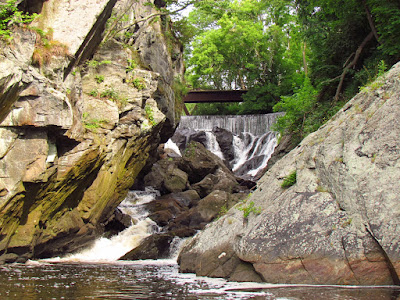 |
| Yantic River |
I return and pass my put in heading up the other river. It leaves the town behind soon enough and becomes a fairly broad and calm river cutting through the eastern hardwood forest. This river is more industrial, or I should say, was more industrial. Arched brick and stone outflow channels show where water was returned to the river after turning the machinery of silenced mills. Sometimes, all that remains is the outflow tunnels, the mill buildings gone from the landscape.
Sparse but large boulders in midstream herald the coming of a shallow and swift rock garden, which is passable by watching and carefully keeping to water that is deep enough for a full paddle stroke.
A very large mill appears...looms...on the left bank. Four or five stories tall and a couple hundred feet long it is roofless and abandoned. The wall facing the river has tall glass block windows...more than half the wall is glass block windows. At the base are six outflow tunnels. I pass by and continue on up to within a couple hundred yards of the Greenville dam. It is typical of big river dams in Connecticut. The state still has over 4000 dams.
Most are small containment structures or seasonal diversion dams to power some mill that operated only when there was enough water. Of those 4000 dams, only 4 were designed for hydroelectric power. The Greenville dam runs a small "modern" generator, but it originally diverted water into a side canal that fed mills along the river...turning their machinery by turning water wheels. That big glass block walled mill had several water wheels inside running its machines.
 |
| The Greenville Dam |
On my way out I stop to explore the bank near the mill. I collect a check writing machine that fell not to far from where it was used.
I manage to get about 75 feet up into one of outflow tunnels.
I could poke around in this area some more....must return.








No comments:
Post a Comment